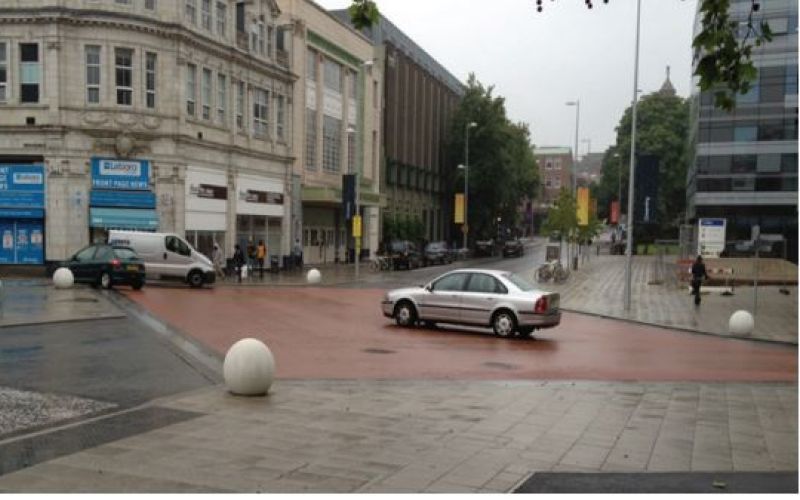A disabled peer has welcomed a new industry review of so-called “shared space” street designs, which has concluded that local authorities should adopt a more “inclusive approach” to them.
The report by the Chartered Institution of Highways and Transportation (CIHT) looked at 11 shared space developments across England, but found evidence that only one of them had made the environment more inclusive.
Most of the schemes had either a neutral impact on inclusion, or demonstrated a mix of positive and negative impacts.
Shared space schemes often remove kerbs and controlled crossings from a street, encouraging vehicles, pedestrians and cyclists to share the same space, but posing greater risks for partially-sighted and blind people, as well as other disabled people, including many of those with mobility impairments, who have learning difficulties or who are deaf.
Last September, campaigners from across the country gathered outside parliament to call for an end to unsafe shared space street designs, which they said risked turning public spaces into “no go zones” for many disabled and older people.
The CIHT review says that some of the schemes “had attracted significant criticism from some groups of users”, and that the impact on inclusion “appeared to vary between different user groups”.
It concludes: “For some user groups such as wheelchair users and older people, there was evidence that particular features of certain schemes had improved their experience.
“However, some visually impaired users were reported as finding the new environments more hostile and consequently said that they altered their behaviour to avoid them.
“Only one case study had included creating an inclusive environment as an objective in the development of the scheme.”
It also pointed out that some schemes had failed to involve disabled people in the consultation process, which appeared to reflect the failure to make the creation of an inclusive environment a “specific aim” for most of the projects.
And it concluded that there was a need for an “inclusive approach” to the use of kerbs and controlled crossings, and that future schemes needed to ensure that the area being redesigned became more inclusive.
The review did find that in four of the schemes the number of accidents and injuries appeared to have fallen following the changes, but accepted that this could have been because of “vulnerable people avoiding the completed scheme”.
The review said that “there should be sufficient provision for all users to cross the carriageway safely and in comfort”.
And it concluded that, where a street needs to be “separated into a carriageway and footway, the interface between them should be clearly delineated and detectable by all” and that “in most situations, a kerb will be the most appropriate and simple way of achieving this”.
Among its recommendations, the review calls on the government to make clear to local authorities their Equality Act 2010 duties when carrying out such developments, and to ensure they know that “stakeholder engagement is an essential part of the process”.
It also calls for education and continuing professional development for those working in the field to cover accessibility and creating inclusive environments.
Lord [Chris] Holmes, the disabled Tory peer, who was a member of the report’s steering group, and has raised repeated concerns about the safety of shared space developments, welcomed the report’s conclusions.
He said the “most striking” conclusion was that only one of the 11 case studies was found to have a positive impact on the inclusive environment, and that was a scheme described as “very much on the limit of what might be called shared space”.
He praised CIHT – which represents professionals who plan, design, build, manage and operate transport and infrastructure – for “taking the issue of accessibility and inclusion in the public realm seriously”.
He has previously called for “an immediate moratorium on all shared space” and has described such projects as “dangerous and costly planning follies” that are turning town centres into “dangerous third world traffic free-for-alls”.
He has also accused “overzealous councils” of “risking public safety for aesthetics”, leading to “confusion, chaos, unnecessary cost and catastrophe”.
He said this week: “I am delighted that the recommendations include ensuring that local authorities understand their duties with regard to the Equality Act and also recognise that greater awareness, better training, more research and improved guidance are all needed.”
He added: “I’m also delighted that the report concludes – regarding crossings – that ‘there should be sufficient provision for all users to cross the carriageway safely and in comfort’ and – regarding kerbs – that the separation between carriageway and footway ‘should be clearly delineated and detectable by all’.
“It is essential that all our public spaces are safe, inclusive places for us all to enjoy.”
The sight loss charity RNIB also welcome the report’s publication.
Hugh Huddy, RNIB’s policy manager, said: “RNIB welcomes the publication of CIHT’s review of shared space and agree an inclusive approach to road design is needed.
“We’re now urging the Department for Transport to reform national guidance and make high streets safe again for blind and partially sighted pedestrians.”
A Department for Transport spokeswoman said: “We are absolutely clear that the needs of the whole community must be considered by councils looking to introduce any public realm scheme – including shared spaces.
“We will consider this report’s findings and develop next steps in due course.”
Picture: One of the shared space schemes examined by the review, Gosford Street in Coventry

 Frustration after government only issues partial ban on new floating bus stops
Frustration after government only issues partial ban on new floating bus stops Making all self-driving pilot schemes accessible would be ‘counter-productive’ and slow us down, says minister
Making all self-driving pilot schemes accessible would be ‘counter-productive’ and slow us down, says minister Self-driving taxis that are not accessible will be allowed pilot scheme licenses, government suggests
Self-driving taxis that are not accessible will be allowed pilot scheme licenses, government suggests